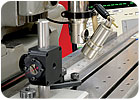
A calibration laboratory should have equipment that is capable of calibrating four to 10 times the resolution of the tools being calibrated. Source: Starrett
Many companies determine that outsourcing precision measurement gages and tools for calibration is the best choice for maintaining accuracy and repeatability vs. in-house calibration methods, which can be error-prone and more expensive to set up, equip, staff and maintain. After the decision is made to outsource calibration, it is time to choose a reliable source.
1. Start with Accreditation.An accredited calibration laboratory will adhere to specific management and technical requirements for running a quality operation. An accredited laboratory will ensure compliance with today’s ever-changing standards.
A reputable calibration laboratory will be accredited through an accreditation body recognized by the International Laboratory Accreditation Cooperation (ILAC); it also will be a signatory to the ILAC mutual recognition arrangement (MRA), which promotes the international acceptance of accredited calibration results.
An ILAC MRA signatory will be an accreditation body that accredits in accordance with ANSI/NCSL Z540-1, a combination of the consensus national standard for the United States and ISO Guide 25, the primary document recognized by the international community to ensure calibration laboratory competence.
Furthermore, accreditation granted by an ILAC MRA signatory is based on internationally accepted criteria for competence established by ISO/IEC 17025: 2005 General Requirements for the Competence of Calibration and Testing Laboratories. Such accreditation facilitates the acceptance of test and calibration data among other accredited laboratories around the globe.
2. Equipment.In accordance with 17025 accreditation, a laboratory needs to have certain equipment to perform calibration services. This includes equipment that is capable of calibrating to very fine resolutions-usually four to 10 times the resolution of the tools being calibrated. For example, good calibration equipment includes gage blocks and lasers that are accurate up to millionths of an inch.
In addition, the calibration equipment itself must receive regular calibration and maintenance in order to be reliable. Calibration laboratory equipment should be on a calibration cycle to ensure accuracy and repeatability that will maintain the laboratory’s measured uncertainties. The test equipment should be traceable to the International System of Units (SI); calibration services that are accredited to 17025 will have such equipment.
3. Experience and Size.It is a good rule of thumb to learn how long the laboratory has been performing calibration. Solid experience and a lengthy track record can be good indicators that the laboratory knows its trade well.
Consider the number of employees at a calibration laboratory. Be cautioned that even when there is a specialist in certain product areas, it is not uncommon to see smaller one- or two-person outfits go out of business.

Calibration laboratory equipment should be on a calibration cycle to ensure accuracy and repeatability that will maintain the laboratory’s measured uncertainties. Source: Starrett
If possible, schedule a visit to tour the calibration facility. A firsthand look at operations can reveal how the facility is being run. Is it clean and orderly vs. untidy and unorganized?
In addition, laboratory accreditation to 17025 requires a documented management system. This obliges the laboratory to define quality policies, document services offered, adhere to its own documentation and keep a record of calibration services.
5. Scope of Service and Documentation.Most companies have gages from different manufacturers so it is best to work with a calibration laboratory that can handle all major brands in one location. It is cumbersome and inefficient to send tools to various sources.
A calibration laboratory should be able to service a wide variety of tools and gages including angle blocks, bore gages, bubble levels, calipers, feeler gages, force gages, gage balls, gage blocks, height gages, indicators, length standards, micrometers, National Pipe Thread (NPT) thread gages, pin gages, plug gages, radius gages, ring gages, stop watches, thread measuring wires, thread plug gages, thread ring gages and torque gages.
Electronic instrument servicing should be wide ranging and include chart recorders, data loggers, heat treat oven validations, high post testers, humidity indicators, multimeters and ohmmeters. In some cases it might not be convenient or feasible to ship the gage or measurement equipment out for calibration. It may be helpful if the calibration laboratory can perform its services at the customer’s site. For instance, an optical comparator is not easily moved.
Be sure the calibration laboratory can provide correct documentation after a tool is calibrated. The calibration certificate should include the actual readings taken during the calibration of the tool.
This certificate includes an environmental control statement, actual before and after data, standards used to perform calibration, applicable National Institute of Standards and Technology (NIST) test number and uncertainty statement. The certificate will conform to the requirements of ANSI/NCSL Z540-1, 17025 and ISO Guide 25.
When consistently using a dedicated, independent calibration source, product quality and reliability will increase. Plus, larger companies benefit by standardizing their gage calibration and record keeping within one source. Another obvious benefit to this is convenience.
Precision measurement gages and tools represent a significant investment and are a critical component for manufacturing quality products. The use of an accredited laboratory that can meet an organization’s calibration requirements will ensure that this investment is protected.